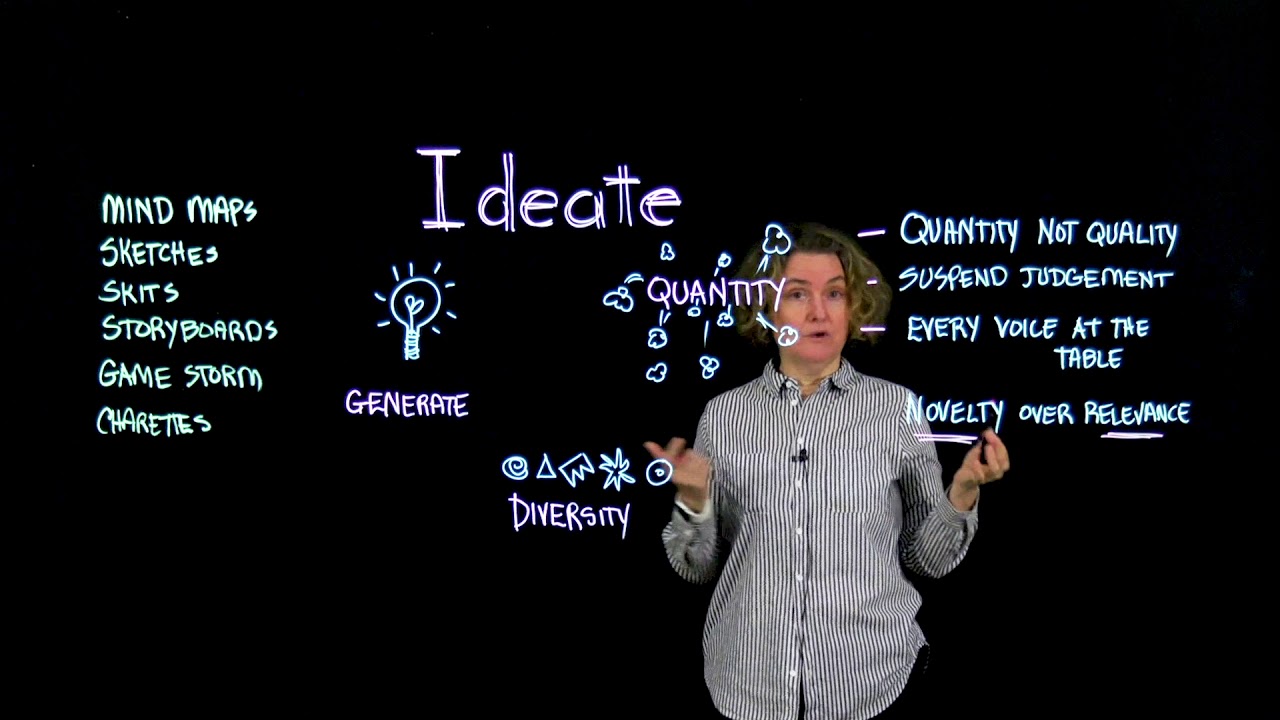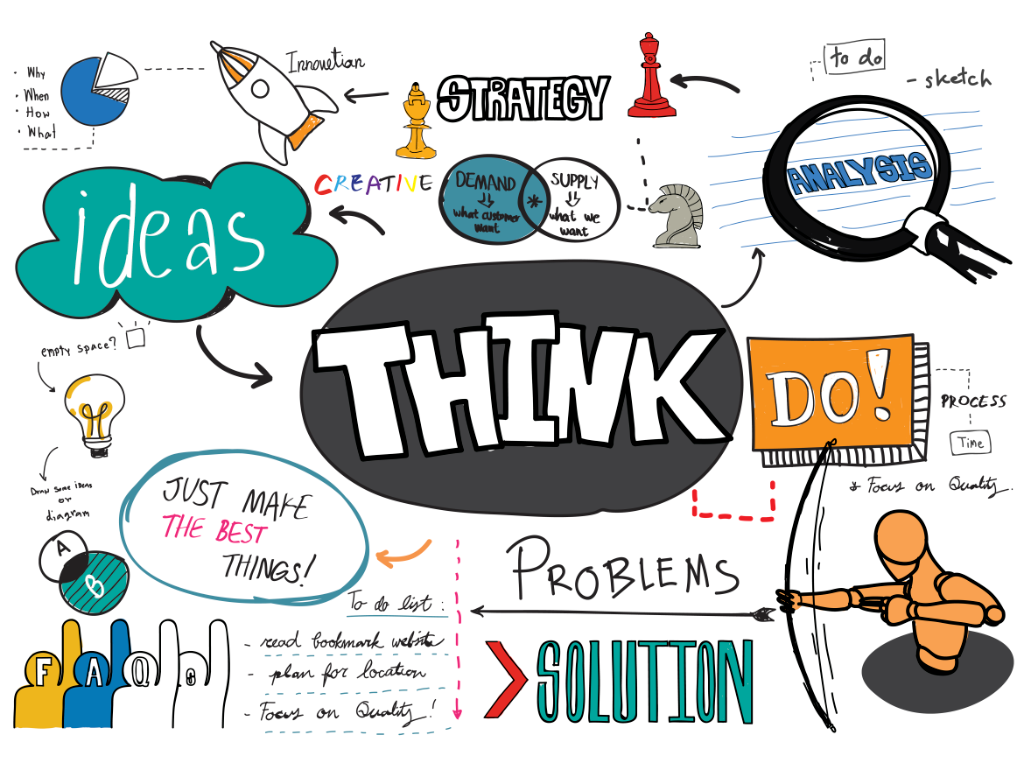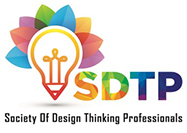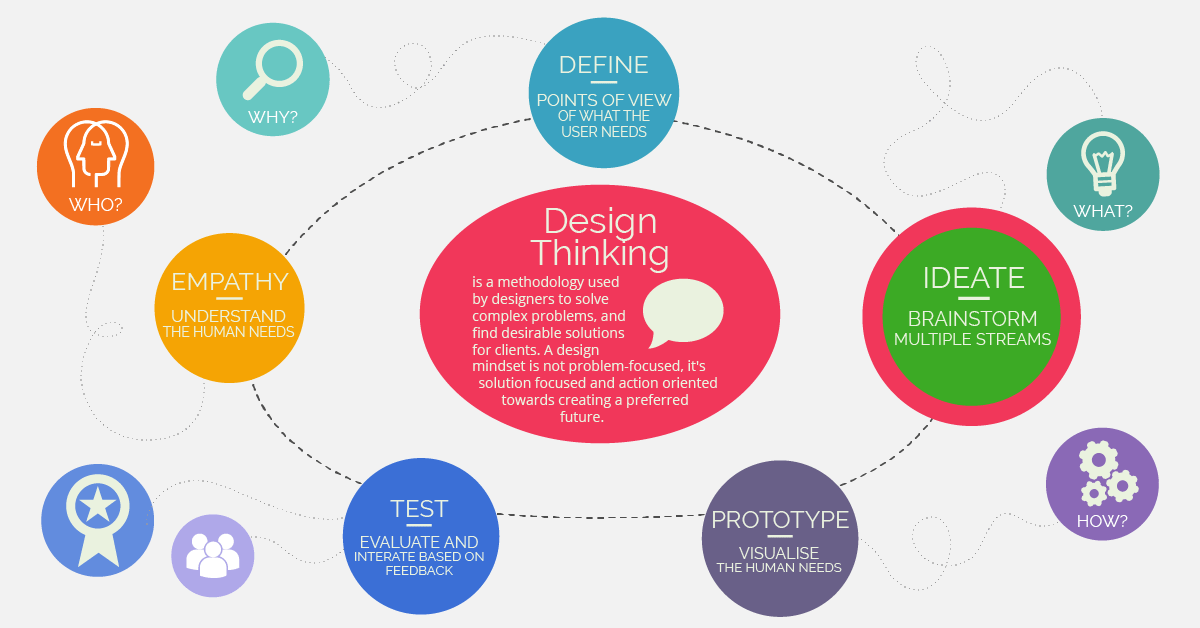“Leave it better than you found it.” – Bruce A. Nordstrom
Design thinking is looking at the usual things with an unusual pair of glasses. It is all about having different perspectives about a single situation. The third stage of the Design Thinking process is Ideation, and it is the most rigorous of all. The job of the design thinker is to serve as many ideas as possible, for ideas lead to possible solutions. It is a way to challenge an assumption like exploring uncharted territory.
It is one of the most exciting stages of Design Thinking, as its purpose is to choose the best idea out of a large number of ideas on the table. According to the d.school, “It is the stage where a team of thinkers concentrates on producing ideas. It is a mental process of going wide to draw outcomes and concepts. Ideation is a source of material to create prototypes while giving fuel to innovative solutions along the way.
What is Ideation?

As Design Thinking is not a linear process, the five stages might or might not fall in the sequential order. Once the Empathy and Define stages derive proper outcomes, they will lead to the Ideation stage for more productive solutions.
This stage contains multiple ideas, where only a few concepts will qualify to provide the potential solutions to a design challenge. This stage focuses on the number of ideas to explore and unveil new avenues and angles. This stage is ideally known as a judgment-free zone, to fulfil the purpose of bringing creativity and innovation to the table.
Why Is The Ideation Stage Critical?

An ideation session, when done correctly, is where innovation soars full-fledged; it should help you discover the game-changing solution that your users have been lacking! From learning about your users and the problem to coming up with solutions, the ideation phase is a critical stage.
Ideation is critical in motivating us to question the obvious, challenge the usual, and come up with new ideas, as Don Norman discusses in Rethinking Design Thinking. “We make significant progress by questioning the obvious.” This is where breakthroughs occur. We must reconsider the obvious, reformulate our assumptions, and rethink previous answers, techniques, and attitudes.”
The ideation phase is your “safe zone” as a designer, where you can come up with new, perhaps unconventional ideas. It doesn’t matter whether these ideas are plausible or not; what matters is that you go beyond the obvious, tried-and-true solutions.
It gives you ways to focus on the needs of the users, to bring light to different perspectives and creativity of people by ushering in diverse ideas. It is the best way to choose the most innovative ideas to proceed with the process successfully.
How To Ideate?

A right tone with the right pitch is crucial to plan an ideation session. The first step before getting into the techniques is to effectively prepare an ideation session. Below are the steps to follow to reach an innovative solution.
1. Introduce a Change of Event
It’s critical to take yourself—and your team—literally above and beyond your viewpoint, if you want to inspire outside-the-box thinking. The actual environment in which you have your ideation session may seem insignificant, yet it can have a significant impact. Remove yourself from your typical environments, such as the boardroom or your desk, and hold the meeting somewhere completely different. New stimuli are introduced in a new context, which might aid to spark new ways of thinking.
2. Choose a Relaxed Space
It’s been proven that both a distraction from the problem and a relaxed state of mind can help you get your creative juices flowing. The most productive brainstorming sessions are those in which the participants are relaxed. The brainstorming phase should be a secure environment, but most people may require some encouragement before they feel comfortable revealing their most outrageous ideas. Prepare some icebreakers to help the group get together, ease stress, and get everyone warmed up.
3. How Might We… Questions
Empathize and Define are the first and second steps of the Design Thinking process, respectively. You’ll have painted a clear image of your users and their demands during these two phases. You’ll also have created a clear problem statement, which is the challenge you’ll need to address during your ideation sessions.
Create a collection of “how might we” questions relevant to your problem statement in advance of ideation. The “how might we” process breaks down your problem statement into manageable chunks, giving it a frame of an opportunity rather than a roadblock.
What do you mean by that? Consider the phrase “how might we…” It implies that a solution is feasible but does not specify what that solution might be. You have just enough of a focal point to direct your ideas while yet having enough room to think laterally and creatively.
4. Ideation Techniques
Now that everything is in place and order, there is this last thing to do: It is time to pick the ideation technique you would want to use. Some of the frequently used ideation techniques are described below.
- Analogy
The process of analogy is cognitive transferring of information or meaning from one subject to another. It is a comparison of one idea to another that is used to explain or clarify anything. What does this have to do with design and concept generation? The analogy technique relates your situation—or design challenge—to something you’re familiar with, allowing you to see the problem from a different perspective and examine potential solutions.
- Brainstorming
When it comes to bringing new ideas to the table as a group, brainstorming is one of the oldest patterns to follow. In a brainstorming session, you vocally bounce ideas off of one another intending to come up with a solution that works for everyone.
- Bodystorming
It is a technique to ideate with a fresh pair of concepts and principles by allowing yourself to deeply submerge in a scenario. It is an approach to empathize genuinely if you’re unable to connect with the problem. What is the mechanism behind it? Using people, artefacts, or a digital prototype, you create a real experience that resembles the problem you’re trying to solve. It may be easier to come up with ideas based on your encounters with and reactions to this setting.
- Brainwriting
Brainwriting is an alternative to traditional brainstorming. Participants write down their ideas before passing them on to someone else, rather than communicating them vocally. The next person reads these suggestions and adds their own, and so on until each person’s thoughts have completed a full rotation. After that, all of the ideas are gathered and presented to the group for debate.
- Brian Walking
This is a more physical and active variation of brainwriting. Rather than handing pieces of paper around the room, the designers go between different “ideation stations” themselves. Before moving on to the next stage, they’ll add their ideas, just like when they’re brainwriting.
- Gamestorming
Gamestorming is a popular technique for both ideation and problem-solving that gamifies brainstorming. Gamifying traditional ideation processes increases engagement and involvement while also allowing some of life’s “rules” to be suspended.
- Challenging Assumptions
It is a fact that challenging assumptions is essential for breaking old thought habits and generating new ones. Creating a list of assumptions that are intrinsic to your design challenge is a popular ideation strategy. You’ll next go over these assumptions as a group and debate whether they’re true or if they’re only there because they’ve never been challenged. You can decide which qualities are truly necessary or which solutions could be employed instead by putting these assumptions to the test.
- Reverse Thinking
Reverse thinking is a fun way to turn a problem inside out and generate new ideas. “How can we make our online courses more accessible?” is the query. “How can we make it as tough as possible for users to take our online courses?” might be replaced with “how can we make it as difficult as possible for users to take our online courses?” The ideas you come up with for the reverse problem can help you imagine what the opposite would be, bringing you closer to the genuine solution.
- Mind Mapping
It is a visual ideation tool created by Tony Buzan in 1972 that helps you to make links between distinct sets of thoughts or facts. You’ll begin by writing a keyword in the page’s middle (normally related to your problem statement). You then surround this term with any concepts that come to mind on the same piece of paper. Finally, consider how these ideas are linked and use lines and curves to illustrate these connections, resulting in a visual map.
- Storyboarding
Storyboarding is an amazing approach to bringing a design challenge to life and visually exploring several options. You can start with visually imagining the personas of the users (as created in the empathy and define stages) using images and quotes. You can then create various plots and outcomes, visualizing how the user feels along the way.
- SCAMPER
SCAMPER is a checklist that will assist you in coming up with new ideas for a specific product or design challenge. It encourages the designer to substitute the topic with something similar; combine the actual topic with added information; adjust the problem by giving an alternative solution; resourcefully modify the topic; put it to other uses by using the topic in identifying different scenarios; eliminate the ideas that are no longer serving the purpose, and reverse and rearrange the problem to come up with a new solution.
- Worst Possible Idea
The worst possible idea technique, similar to reverse thinking, is effective for putting the group at ease and removing creative blockages. Even if the ideation session has been labelled a judgment-free zone, there will inevitably be some pressure to come up with a credible solution that your peers will approve of. This strain is relieved by seeking out the worst possible suggestion. Not only that, but thinking about what’s so bad about these ideas might give important clues about what a good concept might be like.
Consider the nature of your design problem as well as the people who will be participating in the ideation session when determining which brainstorming approaches to use. It’s critical to select strategies that are appropriate for the size of the group. At the same time, think about which techniques are most likely to put your participants at ease and elicit the best reaction from them.
Conclusion
It may take a few brainstorming sessions to narrow down and polish the concept (or ideas) you want to pursue. You’ll move on to prototype and user testing after you’ve accomplished the ideation step. This is where you will put your ideas to the test and identify any flaws that need to be addressed.
As previously stated, the Design Thinking process is not sequential; the prototype and testing stages may reveal that your ideas are unrealistic, forcing you to return to the brainstorming phase—or perhaps back to identifying the problem entirely. When it comes to the brainstorming stage, remember to have fun, try new techniques, and don’t be scared to go out of the line to chase the right solution!
If you are interested in learning Design Thinking in detail, please follow the links given below.
https://www.amazon.in/Thinking-Playbook-Practitioners-Professionals-Publication/dp/1636333745/ref=sr_1_5?crid=1Z3X1ZYMG86J8&keywords=design+thinking+playbook&qid=1641439525&sprefix=design+thinking+playbook%2Caps%2C199&sr=8-5
https://notionpress.com/read/design-thinking-playbook-for-practitioners
Quote Source: https://www.invisionapp.com/inside-design/design-and-creativity-quotes/
Fact Source: https://careerfoundry.com/en/blog/ux-design/what-is-ideation-in-design-thinking/
Image Source: https://alcorfund.com/wp-content/uploads/2020/10/Methods-of-Ideation.png
https://innovationcloud.com/pub/blog/15840010531974_innovation-cloud-de-bono.jpg
https://innovation.kaust.edu.sa/wp-content/uploads/2017/12/Ideate.png
https://i.ytimg.com/vi/zbLxs6te5to/maxresdefault.jpg
Written by: Jimmy Jain & Afreen Fatima
Society of Design Thinking Professionals









